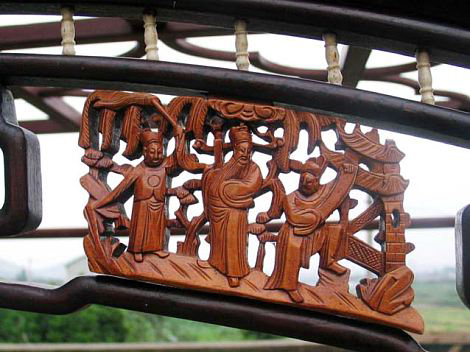Ming, Qing furniture-making reflects artisans’ spirit of craftsmanship

Artisans choose very precious materials for making exquisite Ming and Qing furniture, and wood with beautiful textures is often used for distinct parts of furniture.
Modern artisans operate in an environment where they must often refine their skills, but this includes reverence for past achievements. Many of today’s craftsmen regard Ming and Qing furniture as examples of superb skill. Ming and Qing furniture items represent the pinnacle of craftsmanship, but perhaps more importantly, they are examples of a certain philosophy of craftsmanship that incorporates vivid artistic concepts.
Ming and Qing furniture-making skills were passed down by artisans from mouth to mouth, preserving this traditional furniture culture.
Ming and Qing furniture items have distinct features, such as simple but decorative moldings. The choices made by the artisan and the way in which they utilize the materials available to them are crucial in this respect. Exquisite furniture in the Ming and Qing dynasties was made of precious hard wood due to its distinct texture. When often choosing materials, artisans select wood with beautiful textures for distinct parts of furniture, such as the back of a chair or the tabletop.
Carvings are an inalienable and significant part of Ming and Qing furniture. Its carving techniques consist of circular carvings, reliefs and demi-reliefs, and subjects for these carvings often included rolling grass and lotus patterns, dragon designs, flowers, birds, figures and phoenixes.
A few select furniture carvers became so renowned for their skills that they were favored by the royal family. The highest-quality Qing furniture was made by artisans from the Royal Workshop or zaobanchu. The aspects of the furniture created by these artisans has a direct connection with the background of the Kang-Qian Age. During this period, the Qing Dynasty reached its peak between the reigns of the Kangxi Emperor and Qianlong Emperor. Both the economy and culture achieved unprecedented prosperity, and the Man and Han ethnic groups were integrated. Many handicraft manufacturing skills reached a high level. Based on this situation, Qing furniture absorbed various craft techniques at home and abroad and combined them with their innovative and unconventional features, which laid a solid foundation in the history of Chinese arts and crafts.
Today, there are many people who think that the only furniture that can be considered art is made in a workshop, not via a machine. So when they hear that some furniture companies use machines to produce traditional Chinese furniture, they immediately feel that this behavior doesn’t respect traditional furniture craftsmanship. However, this isn’t necessarily a reasonable conclusion.
The reason why Ming and Qing furniture reached a peak at that time is that its practicability and aesthetic elements realized perfect unity. But its subsequent decline in the late Qing Dynasty was ascribed to its lack of practicability and the high resource input required, which cannot satisfy modern society’s demands. So Chinese furniture making should both inherit traditions and innovate in advance.
Machines are a substitute for manual production, which is a giant step for Chinese furniture. Obviously, handmade furniture carries artisans’ craftsmanship, but the introduction of machines can also save much more time and improve productivity. Besides, many companies still invite artisans to carve the furniture in the last process, which not only retains artisans’ experience but also integrates the accuracy of machine manufacturing.
Relying on large scale production, traditional Chinese furniture can advance with the times. It not only inherits traditional craft-making techniques, but also combines the most advanced manufacturing technology. Therefore, the improvement of technology is both a challenge and opportunity for traditional furniture.
